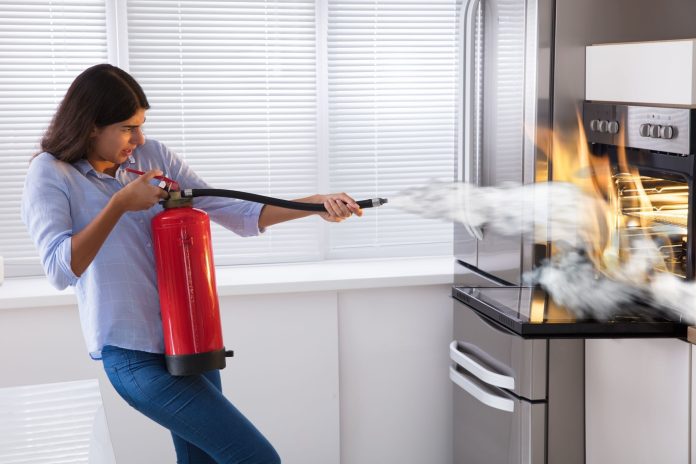Using a fire extinguisher at home can be a critical skill to have in case of a small fire emergency. It’s important to remember the acronym “PASS” to effectively use a fire extinguisher:

PC: bobvila
Pull: Start by pulling the pin from the fire extinguisher’s handle. This step is often necessary to unlock the extinguisher and make it ready for use. The pin is typically located near the top of the extinguisher.
Aim: Aim the nozzle or hose at the base of the fire. You want to direct the extinguishing agent (usually a dry chemical or foam) at the source of the flames, not at the flames themselves. This is because you want to smother the fire by cutting off its oxygen supply.
Squeeze: Squeeze the handle or trigger to release the extinguishing agent. Hold the extinguisher upright while doing this. The extinguishing agent will come out in a jet or spray, depending on the type of extinguisher.
Sweep: Use a sweeping motion from side to side to cover the entire fire with the extinguishing agent. Continue to aim at the base of the fire while sweeping. Make sure you stand at a safe distance, usually about 6-8 feet (1.8-2.4 meters) away from the fire, and approach the fire cautiously if needed.
Some additional tips for using a fire extinguisher at home:

PC: First alert
Always prioritize your safety. If the fire becomes too large, it’s better to evacuate and call the fire department rather than attempting to extinguish it yourself.
Make sure you have the appropriate type of fire extinguisher for the fire you’re dealing with. There are different classes of fire extinguishers for different types of fires (e.g., Class A for ordinary combustibles like wood and paper, Class B for flammable liquids, and Class C for electrical fires).
Be aware of the fire’s location and your escape route. Have your back to the exit so you can quickly retreat if the fire gets out of control.
Follow the manufacturer’s instructions on your fire extinguisher. This may include checking the pressure gauge regularly and ensuring the extinguisher is properly maintained.
Once you’ve used a fire extinguisher, even if only partially, it should be refilled or replaced. Do not assume it’s ready for use again.
After using a fire extinguisher, it’s a good practice to call the fire department to inspect the scene and make sure there’s no risk of re-ignition.
Remember that fire extinguishers are designed for small, contained fires. If a fire continues to grow or becomes uncontrollable, prioritize your safety and evacuate the area while calling 911 for professional assistance.






